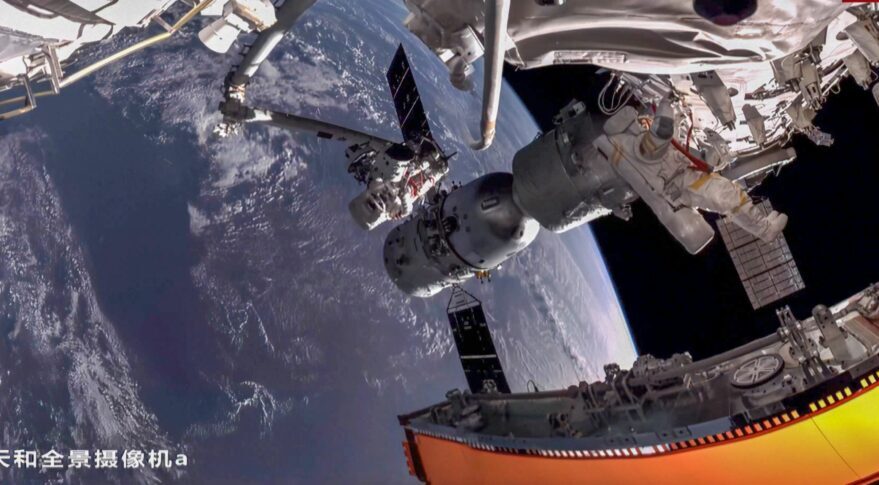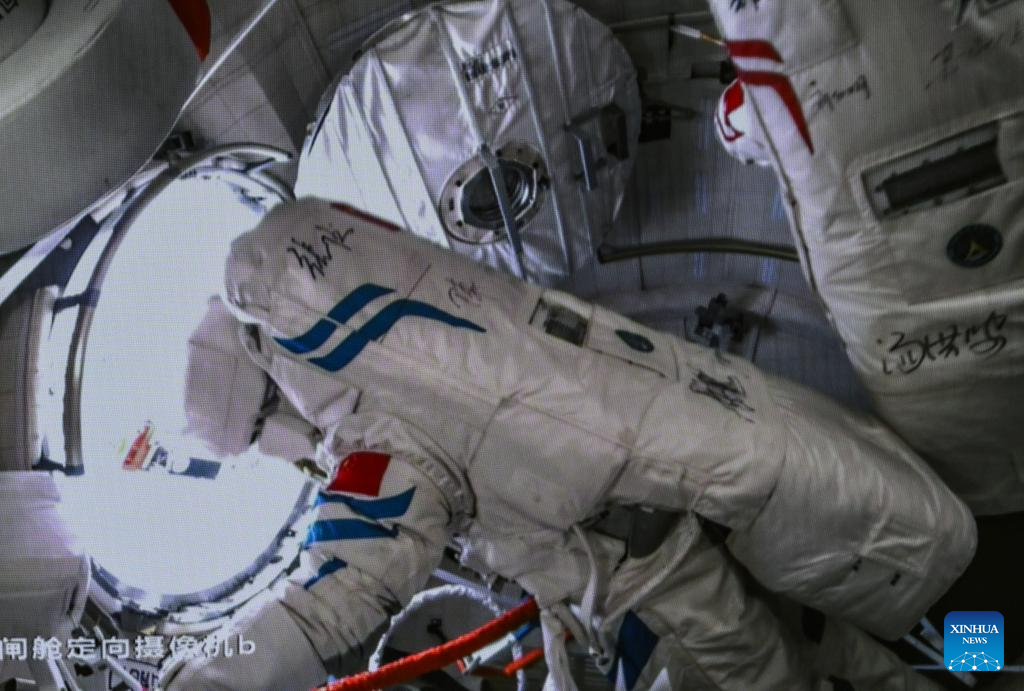The four zebrafish kept on China's Tiangong space station, which is orbiting about 400 km above Earth, are currently in good condition, experts from the Chinese Academy of Sciences (CAS) said Sunday.
The experts revealed details of the latest developments concerning the country's first in-orbit aquatic ecological research project at a public science day event in Beijing.
On April 25, along with the three astronauts aboard the Shenzhou-18 manned spacecraft, four zebrafish and four grams of goldfish algae went into space, and these have been used to establish a self-cycling aquatic ecosystem in orbit, making a breakthrough in the field of raising of vertebrates in space.
According to Zheng Weibo, a researcher at Shanghai Institute of Technical Physics of the CAS, the astronauts have managed to collect water samples twice and have replaced the fish food box once. They found that the zebrafish were showing directional behavior anomalies, such as inverted swimming and rotary movement, in the microgravity environment on Tiangong.
Using the likes of water and fish egg samples, among others, scientists will carry out research on the impact of the space environment on the growth, development and behavior of vertebrates, as well as the material cycle of confined ecosystems in space, Zheng said.
Zebrafish, as a model animal with genetic similarity to humans, can be used for research on many human diseases, said Wang Gaohong, a researcher at the Institute of Hydrobiology of the CAS.
"Meanwhile, like astronauts, zebrafish need to pass through rounds of selection to become 'aquastronauts,'" Wang added.
The Shenzhou-18 crew members, who are currently on board China's space station, will conduct their first extravehicular activities (EVAs) within the next few days, the China Manned Space Agency (CMSA) announced on Monday.
The astronauts, stationed in the orbital complex for the last 32 days, have accomplished a rotation with the Shenzhou-17 crew, attended to the maintenance and upkeep of the space station platform, ensured the upkeep of the life and health support system, conducted inspections and tests on EVA suits, and prepared for spacewalk.
Also, they have engaged in system-wide pressure emergency drills, medical rescue exercises, and other in-orbit training programs.
They have embarked on an array of space science experiments, and completed the second installation of the material exposure experiment apparatus outside the space module, according to the CMSA.
The CMSA said the Shenzhou-18 crew is in good health, and the space station combination is operating smoothly, presenting good conditions for conducting EVAs.
The spacewalk today (May 28) lasted about 8.5 hours.
Two Chinese astronauts just set a new spacewalking record for the country.
Ye Guangfu and Li Guangsu, two members of China's three-person Shenzhou 18 mission, spent about 8.5 hours working outside the Tiangong space stationtoday (May 28).
That's longer than any previous Chinese spacewalk, or extravehicular activity (EVA), according to the nation's state-run Xinhua news service.
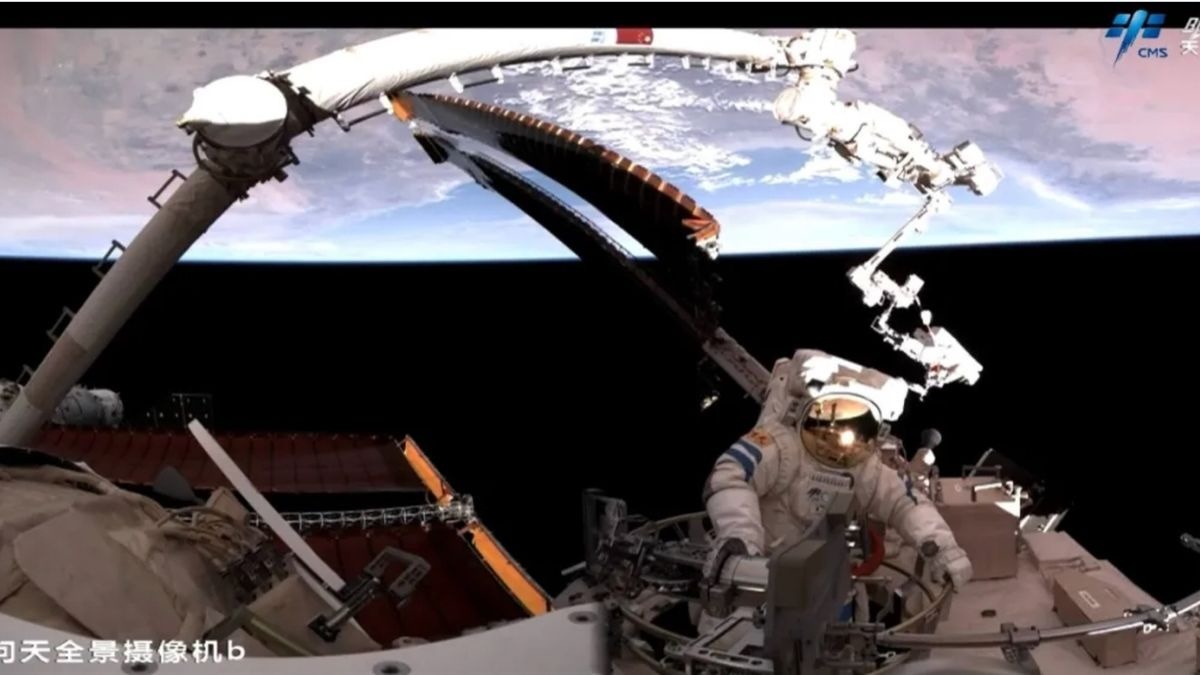
Chinese astronauts conduct the Shenzhou 18 mission's first spacewalk, on May 28, 2024. The excursion lasted about 8.5 hours, setting a new duration record for the nation. (Image credit: CMSA
Ye and Li "completed the installation of the space station's space debrisprotection device and the inspection of extravehicular equipment and facilities," officials with the China Manned Space Agency (CMSA) wrote in an update today. (Translation via Google.)
Space junk is a genuine worry for Chinese space officials; Tiangong suffered a partial power loss recently after a debris strike on its solar arrays, for example.
Today's EVA was the first for Li and the second for Ye, who also stepped outside Tiangong during the Shenzhou 13 mission in December 2021. The third member of the Shenzhou 18 mission, Li Cong, assisted the EVA from inside Tiangong, monitoring the spacewalkers and their activities.
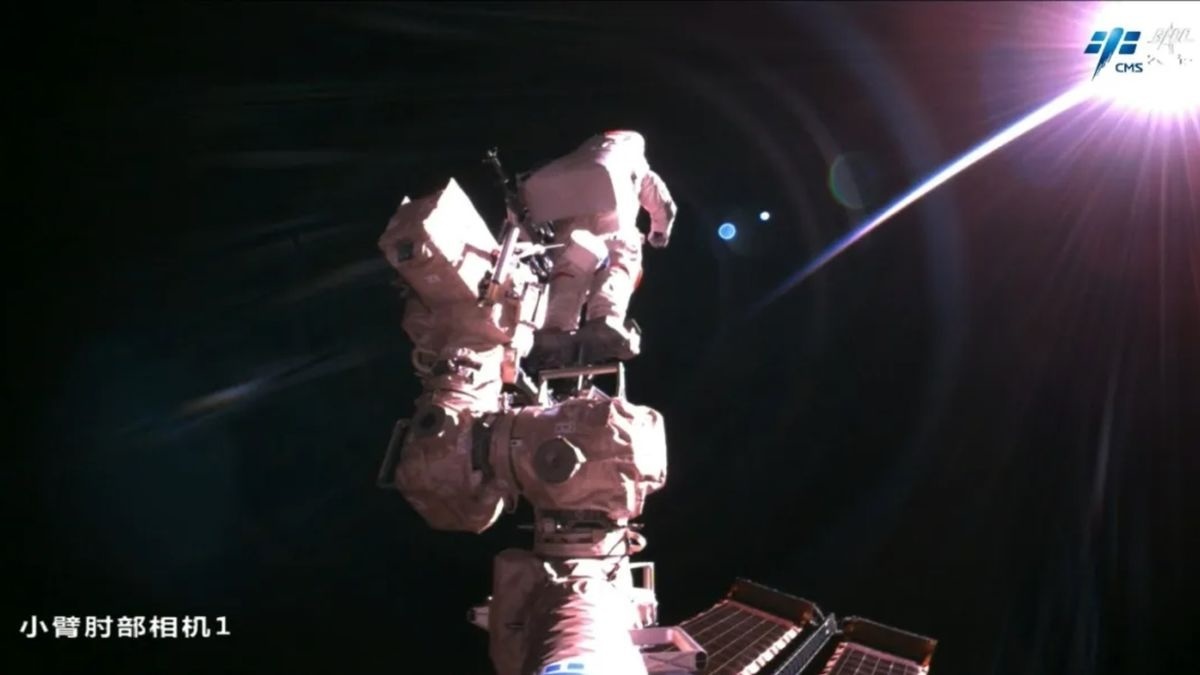
The spacewalkers installed space-debris protection gear outside the Tiangong space station, among other tasks. (Image credit: CMSA
This was the first EVA for the six-month-long Shenzhou 18 mission, which launched to Tiangong in late April. China's previous crewed flight, Shenzhou 17, performed two spacewalks outside Tiangong. Shenzhou 15 set the nation's single-mission mark with four EVAs.
Shenzhou 18 may be similarly active. "According to the plan, a large number of scientific experiments and technical tests, as well as astronaut crew extravehicular activities and application payload extravehicular missions, will be carried out during the Shenzhou 18 manned flight mission," CMSA officials wrote in today's update.
Chinese astronauts have now conducted a total of 16 spacewalks to date, according to Xinhua. The nation's first EVA occurred on Sept. 27, 2008, when Zhai Zhigang ventured outside his Shenzhou 7 capsule for about 20 minutes.
Quelle: SC
+++
Shenzhou-18 crew members complete first spacewalk
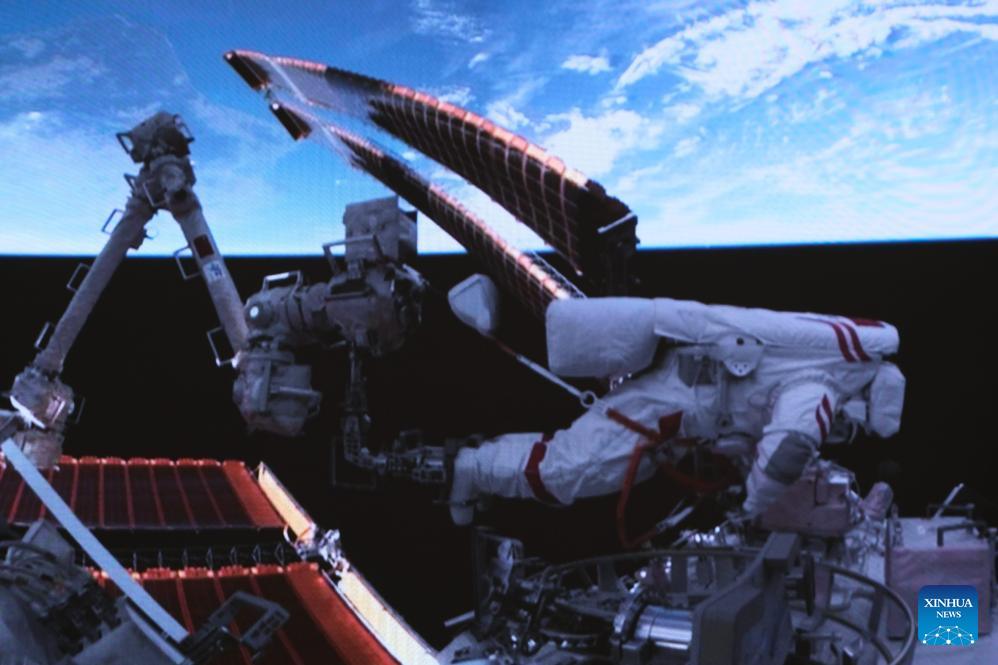
This screen image captured at Beijing Aerospace Control Center on May 28, 2024 shows Shenzhou-18 astronaut Ye Guangfu performing extravehicular activities. The Shenzhou-18 crew members on board China's orbiting space station completed their first spacewalk on Tuesday, according to the China Manned Space Agency. (Xinhua/Li Jie)
Shenzhou-18 crew members on board China's orbiting space station completed the first spacewalk of their mission at 6:58 p.m. (Beijing Time) on Tuesday, according to the China Manned Space Agency (CMSA).
Ye Guangfu, Li Cong and Li Guangsu worked for about eight-and-a-half hours in completing multiple tasks, including the installation of space debris protection devices, and were assisted by the space station's robotic arm and a team on Earth.
The task has set a new record for the longest single spacewalk by Chinese astronauts.
Ye and Li Guangsu, the two crew members assigned the spacewalk duty, have since returned safely to the Wentian lab module.
This marked Ye's second extravehicular activity (EVA), following his initial spacewalk during the Shenzhou-13 mission, while Li Guangsu embarked on a spacewalk for the first time.
The mission will involve numerous other tasks, with the Shenzhou-18 crew set to engage in a slew of scheduled space science experiments and technical tests, while they will also undertake additional extravehicular activities and install payloads outside the space station, according to the CMSA.
So far, Chinese astronauts have successfully carried out a total of 16 EVAs. On Sept. 27, 2008, astronaut Zhai Zhigang in Shenzhou-7 mission made history as China's first person to conduct a spacewalk, which lasted approximately 19 minutes.
The Shenzhou-15 crew has achieved a milestone by performing four spacewalks, marking the highest number of EVAs by a single Chinese astronaut crew.
The Shenzhou-17 crew completed, for the first time, the in-orbit maintenance of extravehicular facilities during their second spacewalk, which lasted approximately eight hours. ■
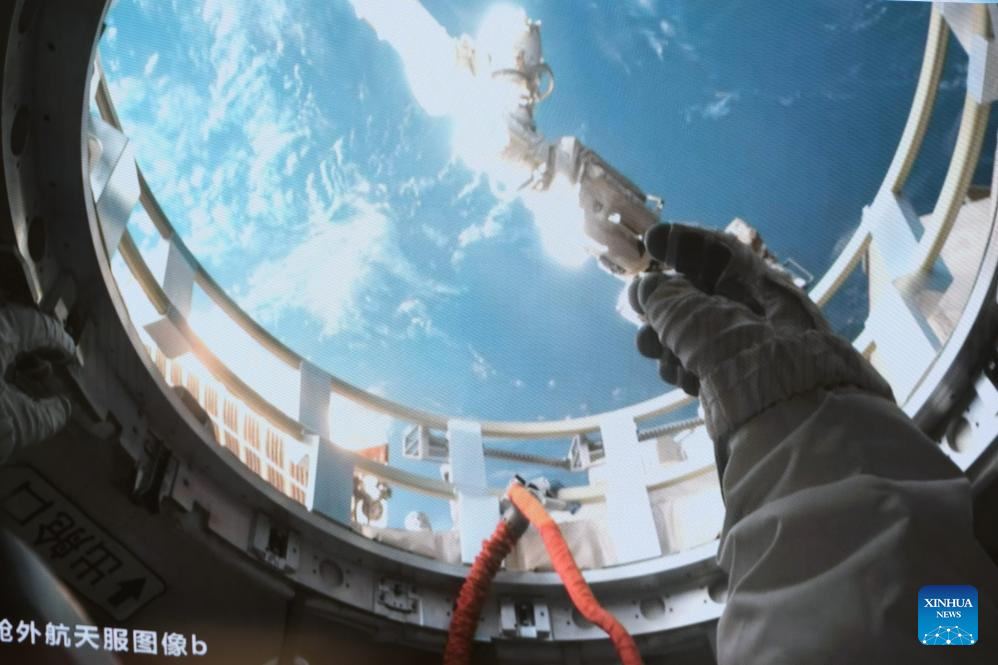
This screen image captured at Beijing Aerospace Control Center on May 28, 2024 shows Shenzhou-18 astronaut Li Guangsu preparing for extravehicular activities. The Shenzhou-18 crew members on board China's orbiting space station completed their first spacewalk on Tuesday, according to the China Manned Space Agency. (Xinhua/Li Jie)

This screen image captured at Beijing Aerospace Control Center on May 28, 2024 shows Shenzhou-18 astronaut Ye Guangfu performing extravehicular activities assisted by the robotic arm of the space station. The Shenzhou-18 crew members on board China's orbiting space station completed their first spacewalk on Tuesday, according to the China Manned Space Agency. (Xinhua/Li Jie)
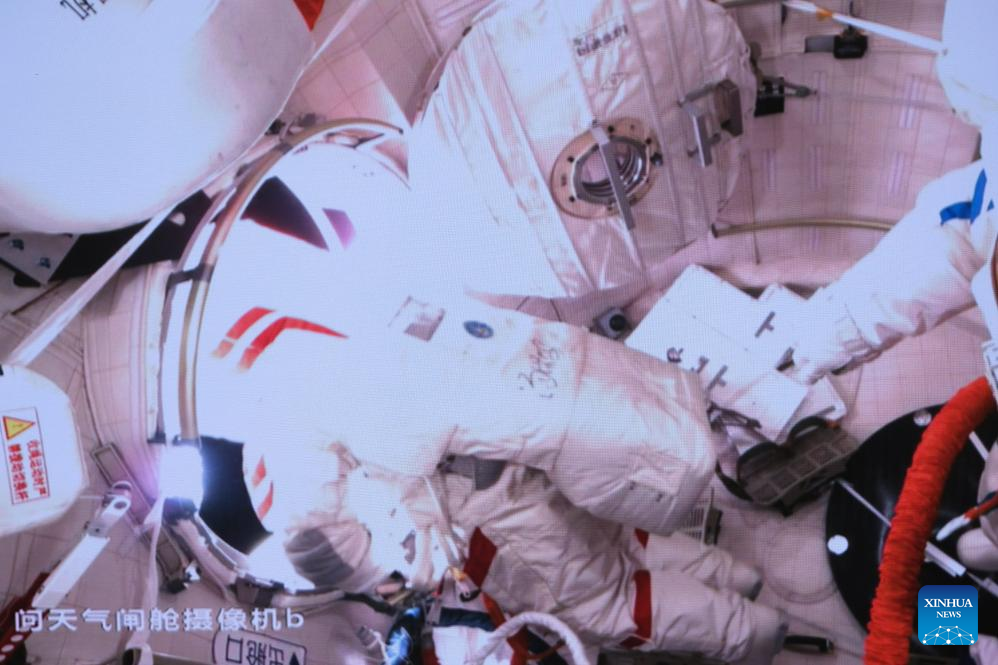
This screen image captured at Beijing Aerospace Control Center on May 28, 2024 shows Shenzhou-18 astronaut Ye Guangfu going out for extravehicular activities. The Shenzhou-18 crew members on board China's orbiting space station completed their first spacewalk on Tuesday, according to the China Manned Space Agency. (Xinhua/Li Jie)
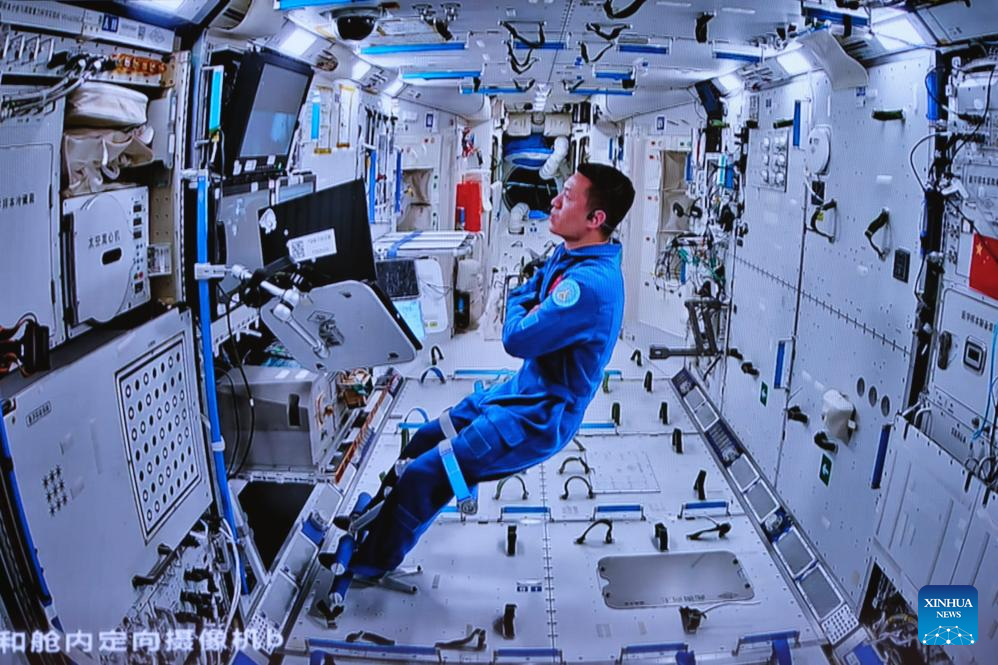
This screen image captured at Beijing Aerospace Control Center on May 28, 2024 shows Shenzhou-18 astronaut Li Cong monitoring the extravehicular activities. The Shenzhou-18 crew members on board China's orbiting space station completed their first spacewalk on Tuesday, according to the China Manned Space Agency. (Xinhua/Li Jie)
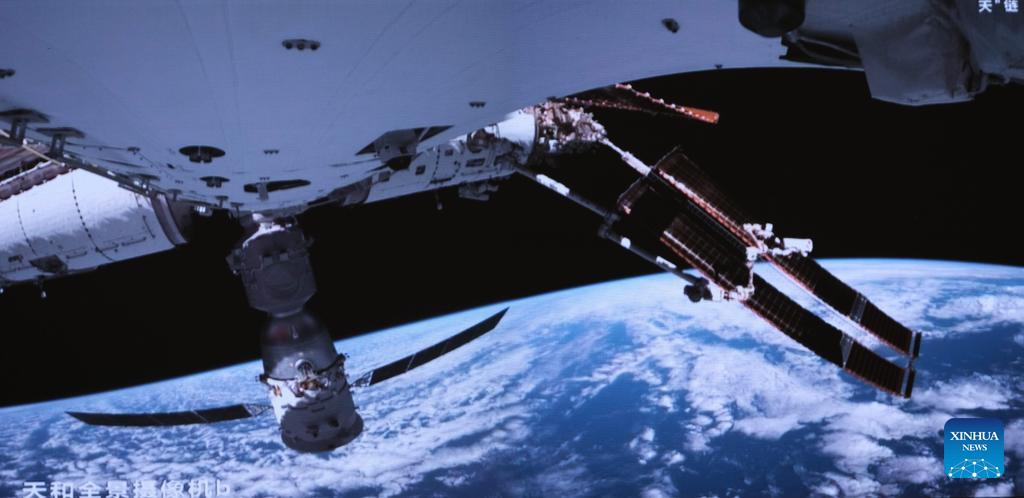
This screen image captured at Beijing Aerospace Control Center on May 28, 2024 shows Shenzhou-18 astronaut Ye Guangfu performing extravehicular activities. The Shenzhou-18 crew members on board China's orbiting space station completed their first spacewalk on Tuesday, according to the China Manned Space Agency. (Xinhua/Li Jie)
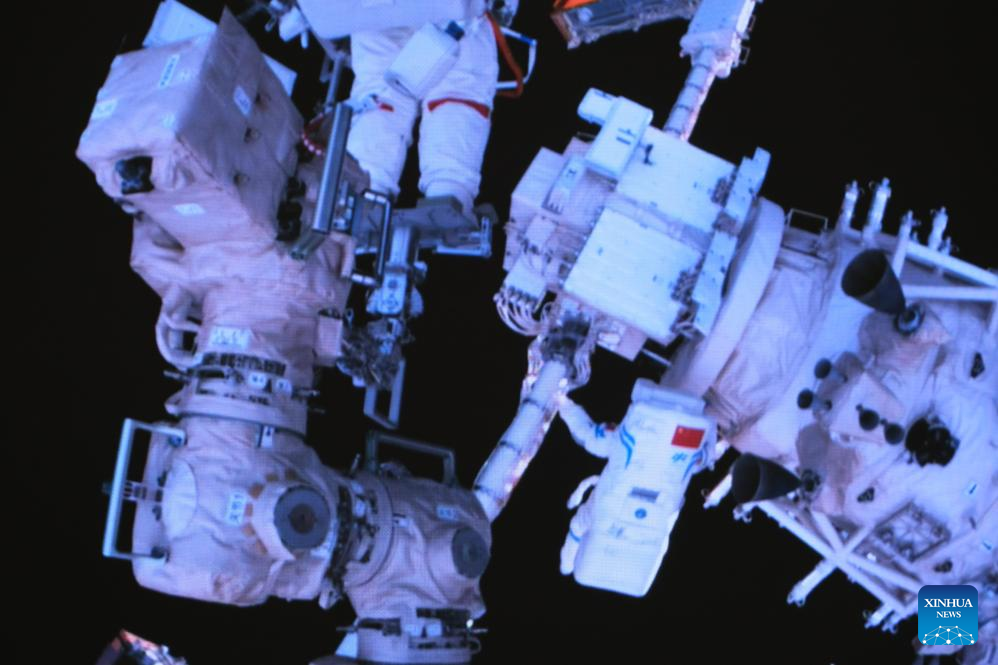
This screen image captured at Beijing Aerospace Control Center on May 28, 2024 shows Shenzhou-18 astronauts performing extravehicular activities. The Shenzhou-18 crew members on board China's orbiting space station completed their first spacewalk on Tuesday, according to the China Manned Space Agency. (Xinhua/Li Jie)
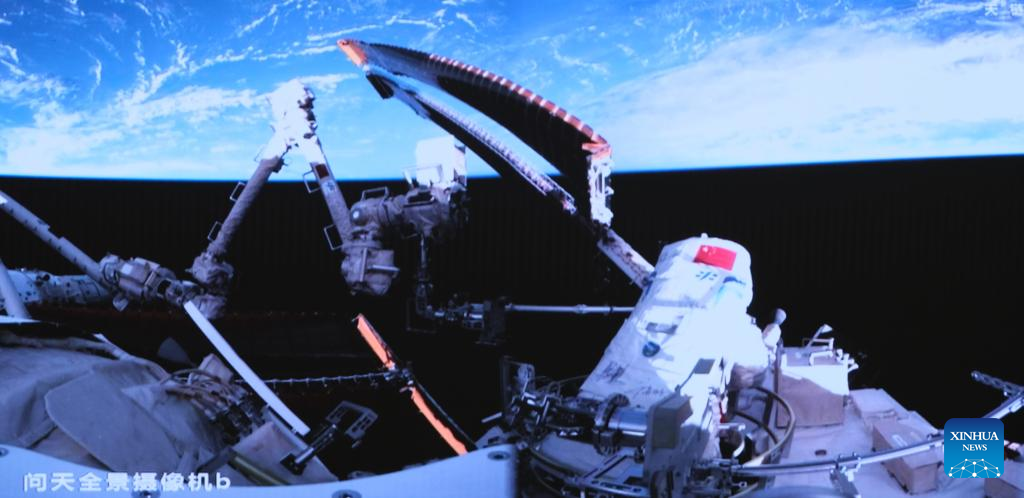
This screen image captured at Beijing Aerospace Control Center on May 28, 2024 shows Shenzhou-18 astronaut Li Guangsu returning to space station after extravehicular activities. The Shenzhou-18 crew members on board China's orbiting space station completed their first spacewalk on Tuesday, according to the China Manned Space Agency. (Xinhua/Li Jie)
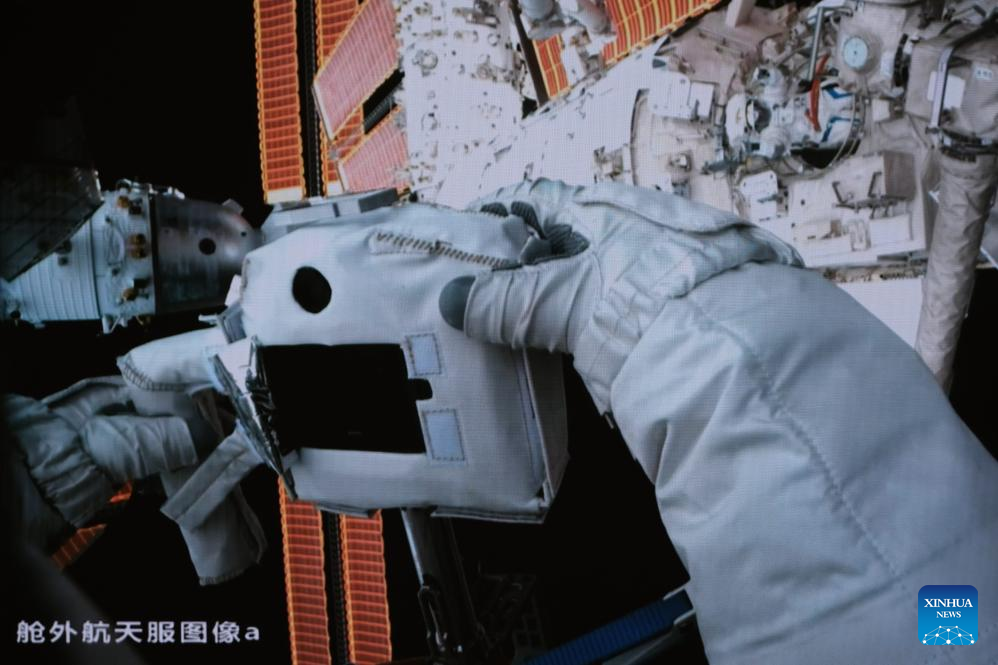
This screen image captured at Beijing Aerospace Control Center on May 28, 2024 shows Shenzhou-18 astronaut Ye Guangfu taking a photo of Li Guangsu during extravehicular activities. The Shenzhou-18 crew members on board China's orbiting space station completed their first spacewalk on Tuesday, according to the China Manned Space Agency. (Xinhua/Li Jie)
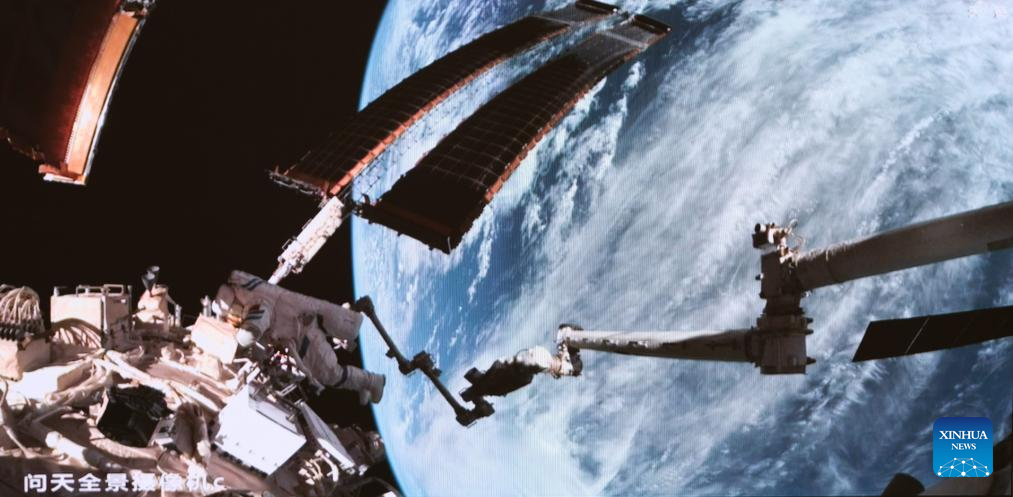
This screen image captured at Beijing Aerospace Control Center on May 28, 2024 shows Shenzhou-18 astronaut Li Guangsu performing extravehicular activities. The Shenzhou-18 crew members on board China's orbiting space station completed their first spacewalk on Tuesday, according to the China Manned Space Agency. (Xinhua/Li Jie)
Quelle: Xinhua
----
Update: 4.07.2024
.
China's Shenzhou 18 astronauts prep for 2nd spacewalk
The trio has also been conducting experiments aboard the Tiangong space station.
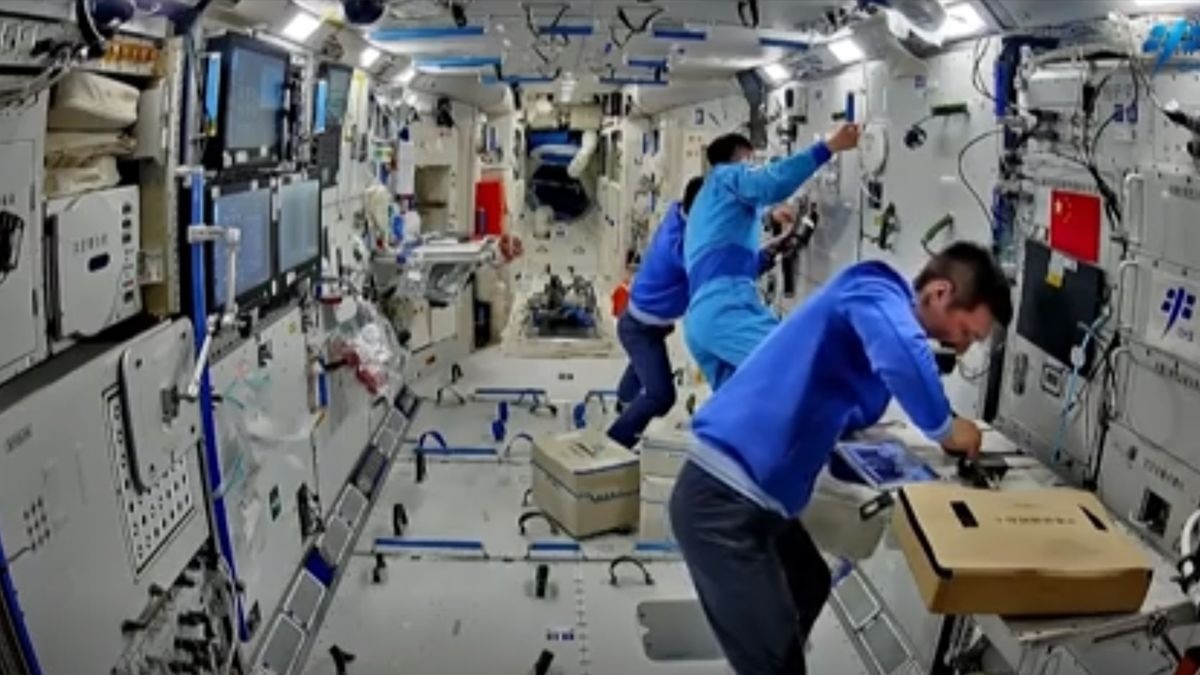
The astronauts of China's Shenzhou 18 mission aboard the Tiangong space station prep for an upcoming spacewalk. (Image credit: CCTV)
China's Shenzhou 18 astronauts are getting ready for a new extravehicular activity outside the Tiangong space station.
The upcoming activities and training include science experiments and orbital maneuvers, according to state broadcaster China Central Television (CCTV).
Commander Ye Guangfu and crewmates Li Cong and Li Guangsu have been aboard Tiangong since April 25.
The trio have been using advanced remote-control systems for rendezvous and docking operations on in-orbit training systems and metacognitive training systems. They have also been practicing skills such as recognizing images, manual docking, remote docking and safe undocking of the spacecraft under different initial conditions. Ye and Li Guangsu completed a national-record spacewalk on May 28.
China's human spaceflight agency confirmed on Tuesday (July 2) that the spacewalk would take place in the near future. Often, the spacewalk will follow the day after such announcements.
The Shenzhou 18 crew have also undergone exercise-based cardiopulmonary function tests. The tests assess the cardiovascular and respiratory capabilities needed for upcoming spacewalks, using methods to simulate exercise-induced metabolic demands, according to CCTV.
Meanwhile, science activities have been continuing aboard the station. Ye, Li and Li conducted maintenance of the combustion science laboratory cabinet by replacing burners, vacuuming and exhausting and organizing related materials, CCTV reported. The crew also replaced samples in the fluid physics laboratory cabinet, which is used to conduct on-orbit microgravityexperiments on kinetic and other processes, including the behavior of different fluid systems.
The astronauts are now just over one-third of the way through their six-month stay aboard Tiangong. They will be joined in orbit by the Shenzhou 19 crew around October or November. Ye and crew will then hand over the station to the incoming astronauts and prepare to return to Earth.
China plans to operate Tiangong for at least a decade.
Quelle: SC
----
Update: 6.07.2024
.
Shenzhou 18 Crew to Conduct Second Extravehicular Activities
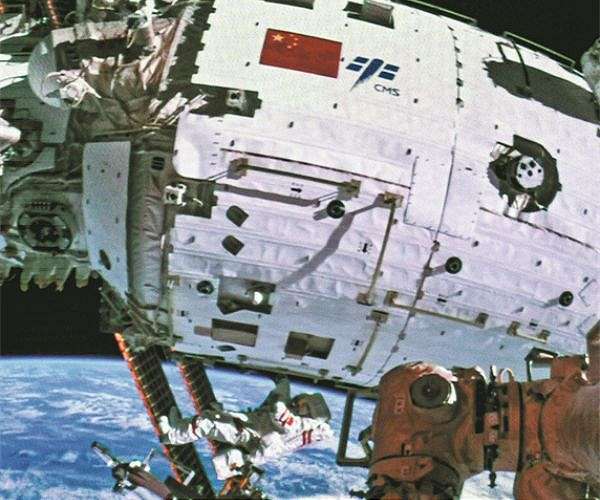
Since the success of the first extravehicular activity on May 28 this year, Shenzhou XVIII crew members have completed tasks sequentially in the space station, including the maintenance and installation of experimental apparatus, environmental monitoring inside the space module and preparation for the second extravehicular activity, according to the China Manned Space Agency.
The crew has been steadily advancing various experiments in the fields of space material science, space life science and aerospace medicine, the agency said.
Currently, the crew members, all born in the 1980s, are in good condition, and the space station complex is operating smoothly. They will soon carry out their second extravehicular activity according to the right condition, according to CCTV news.
Quelle: SD
